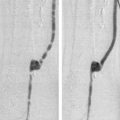Description
A typical set comprises:
- •
A one- or two-part 22G needle for the initial puncture
- •
A short 0.018-inch guidewire with flexible tip and supportive shaft
- •
An interlocked dilator system. This varies from kit to kit. Those for hepatic and renal work often come with a metal stiffening cannula in addition to a coaxial inner dilator with a tapering tip inserted through a larger outer dilator, which will accept a 0.035/0.038-inch guidewire.
Remember to remove the inner dilator to allow insertion of the 0.035-inch wire.
Know what to ask for
Vascular access sets
Mini-access set
This set is usually used for vascular access and has an inner 3F dilator and an outer 4F dilator. This permits introduction of the 0.035-inch wire.
Pedal access kit
This is very similar but has been specifically designed to help access the smallest of vessels. The needle is only 4 cm long and this makes back bleeding more obvious when the lumen has been accessed. The pedal access kit comes with a 0.021-inch wire, the coaxial dilator has an outer diameter of 4F and also a removable haemostatic valve, which allows this to be converted to a 2.9–3F ‘mini-sheath’.
Non-vascular access sets
Coaxial access set (neff/accustick)
This is the one to ask for if you are performing non-vascular intervention. Not only do you get a longer puncture needle but the sheath system has an inner metal stiffener to help prevent kinking of the guidewire and support the catheters as they pass through tissues/organs into deeper structures. In most of the kits, the final sheathed dilator will be at least 6F and often have a radio-opaque end-marker.




